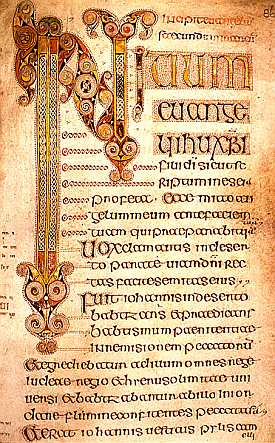The World’s Best Bible-Reading Program
January 11, 2007
Posted by Dan Edelen in : Best of Cerulean Sanctum, Bible Functions : Trackback,
 ,
, 
Last year, I decided to try a one-year Bible-reading plan because I’m one of those people who lives in cycles of near-coma transitioning into frenzy and back again. (Don’t ask me to do ANYTHING before noon.) That served me well until about age forty, but now I can’t seem to handle the mania like I once did.
So rather than the feast or famine approach I took to Bible reading in 2005 (not my normal pattern, either), I decided to try something highly structured and methodical. As someone who loves Scottish preachers,  I threw my allegiance to the Robert Murray M’Cheyne Bible-reading plan.
I threw my allegiance to the Robert Murray M’Cheyne Bible-reading plan.
That lasted four months before I threw in the towel.
Plenty of Bible-reading systems exist, with M’Cheyne’s one of the most popular. No doubt M’Cheyne and I will not cross paths in heaven given that he’ll be next to the throne of God, while I’ll be resigned to a distant spot on the outer edge of things, but this doesn’t change the fact that his Bible-reading program’s not all that good.
The problem, as I see it, is that all such programs miss the point. While reading through the Bible in a year is a worthy endeavor, it’s an artificial one. God’s not so much interested in us making it through all 66 books in 365.25 days. What He desires of us is that we understand what we read in His word, ruminate on it, and then do something with what we’ve read. With some of the plans out there, I could spend an entire year reading the Bible and not remember one whit of it, nor put into practice even one of its commands.
Sadly, that seems to be what a lot of Christians do. Don’t believe me? Just take a look at the state of the world, and especially the biblical ignorance rampant in the Church in America.
Beyond the artifice behind them, most Bible-reading plans suffer from an imposed superficiality and disjointedness. This latter problem drove me off the M’Cheyne plan. It included an OT reading, a Psalm, a Gospel, and an Epistle all in one day. The next day, move up a chapter in each. Is it any wonder that the unity of the Scriptures begins to fall apart when read that way? Yes, I’m reading the Bible! But I’m not putting it all together into a whole that transforms my life.
One of the posts I featured in my “The Best of Cerulean Sanctum 2006” is entitled “Chapter, Verse, Blog” (it’s a good read; make certain to follow the link to the Viola piece). The main idea in that post concerns the artificial chapter and verse system we’ve imposed on God’s word. It may come as a shock to some people, but the chaptering system we’re so familiar with did not exist until eleven centuries after the New Testament came to be. The verse system came three hundred years after that. In other words, when the greatest saints of the Church read the Scriptures, they thought of them solely as uniform books. Today, we think of them more as chapters and verses. Most reading plans slavishly obey chapter delineation for no good reason other than convenience. But God never intended His word to be “convenient.”
The World’s Best Bible-Reading Program, as I see it, moves beyond this piecemeal approach to reading the Scriptures. It has nothing to do with the proud announcement that “I read through the entire Bible this year!” Instead, it has everything to do with knowing the word of God and putting it into practice. It’s not a one-year reading program, but a “rest of your life until they bury you in a pine box” program. The first way of thinking is marketing; the other is transforming.
Here’s how The World’s Best Bible-Reading Program works:
1. Find a quiet, undisturbed place to read. Start in the New Testament since the New Covenant is necessary for perspective on the Old Testament. Might as well begin with Matthew.
2. Read through one entire book in a single sitting. Obviously, the first five books of the NT are going to require some time. But do it. (You’re eternal. Live like it!) These books are whole units and are meant to be read as such. We need to experience their coherence. Trust me; the Holy Spirit will bring the entirety of the book to your mind in the future in a way you’ve never experienced before.
3. When you’ve read the book once, don’t move on! Read through it again. For the first five books, if you must break them into chunks, go with five or six chapters—whatever maintains the arc of the narrative.
4. Re-read that one book. Note the way the narrative and themes flow. Commit those stories and themes to memory. Note where they exist in the book.
5. Re-read that one book. Pay special attention to the way the Lord is portrayed.
6. Re-read that one book. Examine the relational aspects of the book, God to Man, Man to Man, Man to God.
7. Re-read that one book. Note the Lord’s redeeming and salvific acts within the greater arc of Creation, Fall, Redemption, and Restoration. (This first pass through the NT assumes you have a modicum of OT understanding. After reading the OT through, the second pass through the NT will clarify things further.)
8. Re-read that one book. This time around, note all the Lord’s commands and how we’re told to practice them. Consider how they might work practically in your daily activities.
(By this point, you’ve read the same book seven times. Depending on the length of the book, it may have taken seven days or seven weeks. It doesn’t matter. This is about changing your life and relationship with Christ. This is about sixty years of discipleship. It’s not about getting through the Bible in a certain length of time.)
Now comes the hard (and controversial) part…
9. Take everything you’ve learned in this book and put it into practice. Take a month (*see comments below) to do nothing but concertedly meditate on what you’ve just read by making it real in your own life. It might mean that the only Bible you read this month are the parts of this one book that you still aren’t getting and must re-read. Doesn’t matter—do it. (If you absolutely have to read something every day that isn’t part of this program, consider a few Psalms or a cycle of Proverbs. They’re the most suited to broken-up reading patterns since they are collections of wisdom and less unified than a book like Romans.)
10. After your month, take stock of all that you’ve learned by reading and practice. Make a mental assessment of the themes of the book and how they apply to your discipleship. If you’re confident you’ve read and practiced this book, move on to the next one. Once the NT is finished, move onto the OT. (I realize some of the OT books are daunting in length for a single read-through. Make a concerted effort to read them in one sitting. Failing this, some of the OT books are narrative, which allows for breaks in the story. Psalms and Proverbs are easily segmented, as noted above. All prophets must be read in one sitting the first time through. A book as enormous as Isaiah is hard to partition, so consider reading it on a weekend day.)
Repeat these ten steps for the rest of your life.
George Barna’s dire poll warnings about Biblical ignorance today in Evangelical churches largely reflect the piecemeal approach we take to reading the Scriptures. Too much of our reading and teaching are topical, destroying the uniformity of the revelation. That so few churches preach through the entirety of the Scriptures in the way outlined in this reading programs explains our ignorance, too. Bible reading programs that reduce the Bible to tatters only compound the problem. So does the lack of digesting what we read.
I can’t guarantee many of the things I write here at Cerulean Sanctum, but I guarantee this: If you make The World’s Best Bible-Reading Program your lifetime plan of reading the Bible, you’ll be transformed.
And you can take that with you to eternity.




No comments:
Post a Comment